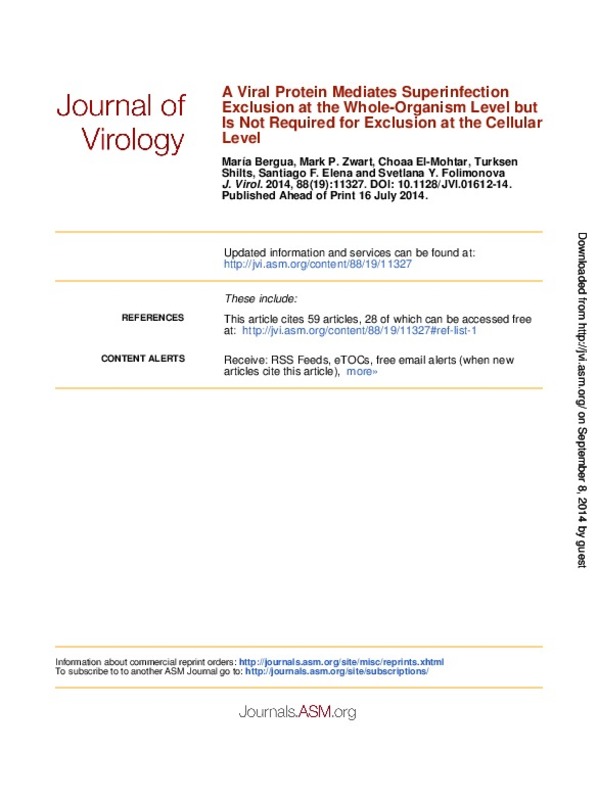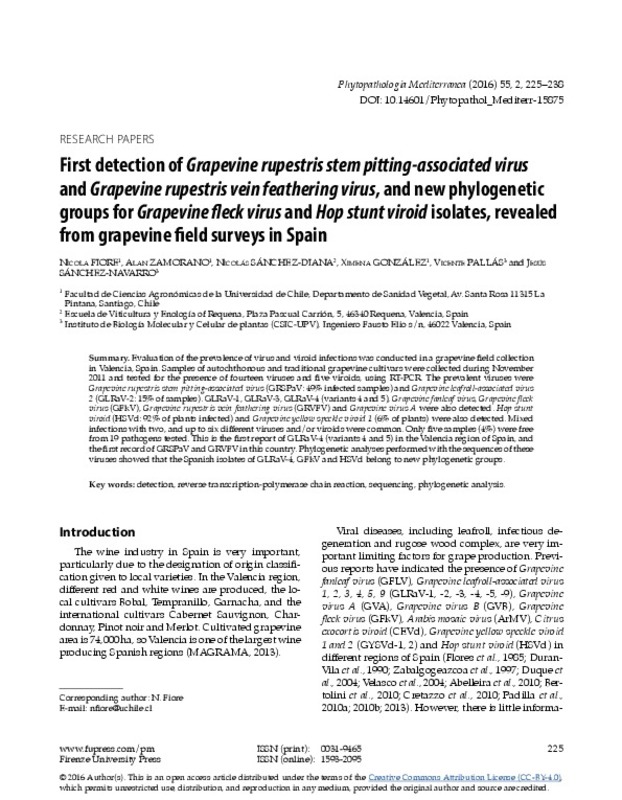|
Resumen:
|
[EN] Superinfection exclusion (SIE), the ability of an established virus infection to interfere with a secondary infection by the same or a closely related virus, has been described for different viruses, including important ...[+]
[EN] Superinfection exclusion (SIE), the ability of an established virus infection to interfere with a secondary infection by the same or a closely related virus, has been described for different viruses, including important pathogens of humans, animals, and plants. Citrus tristeza virus (CTV), a positive-sense RNA virus, represents a valuable model system for studying SIE due to the existence of several phylogenetically distinct strains. Furthermore, CTV allows SIE to be examined at the whole-organism level. Previously, we demonstrated that SIE by CTV is a virus-controlled function that requires the viral protein p33. In this study, we show that p33 mediates SIE at the whole-organism level, while it is not required for exclusion at the cellular level. Primary infection of a host with a fluorescent protein-tagged CTV variant lacking p33 did not interfere with the establishment of a secondary infection by the same virus labeled with a different fluorescent protein. However, cellular coinfection by both viruses was rare. The obtained observations, along with estimates of the cellular multiplicity of infection (MOI) and MOI model selection, suggested that low levels of cellular coinfection appear to be best explained by exclusion at the cellular level. Based on these results, we propose that SIE by CTV is operated at two levels-the cellular and the whole-organism levels-by two distinct mechanisms that could function independently. This novel aspect of viral SIE highlights the intriguing complexity of this phenomenon, further understanding of which may open up new avenues to manage virus diseases.
IMPORTANCE
Many viruses exhibit superinfection exclusion (SIE), the ability of an established virus infection to interfere with a secondary infection by related viruses. SIE plays an important role in the pathogenesis and evolution of virus populations. The observations described here suggest that SIE could be controlled independently at different levels of the host: the whole-organism level or the level of individual cells. The p33 protein of citrus tristeza virus (CTV), an RNA virus, was shown to mediate SIE at the whole-organism level, while it appeared not to be required for exclusion at the cellular level. SIE by CTV is, therefore, highly complex and appears to use mechanisms different from those proposed for other viruses. A better understanding of this phenomenon may lead to the development of new strategies for controlling viral diseases in human populations and agroecosystems.
[-]
|
|
Código del Proyecto:
|
info:eu-repo/grantAgreement/NSF//1050883/US/Mechanism of Superinfection Exclusion By An RNA Virus/
info:eu-repo/grantAgreement/MINECO//BFU2012-30805/ES/EVOLUTIONARY SYSTEMS VIROLOGY: EPISTASIS AND THE RUGGEDNESS OF ADAPTIVE LANDSCAPES, MUTATIONS IN REGULATORY SEQUENCES, AND THE HOST DETERMINANTS OF VIRAL FITNESS/
info:eu-repo/grantAgreement/MICINN//JCI-2011-10379/ES/JCI-2011-10379/
|
|
Agradecimientos:
|
This research was supported by the National Science Foundation under grant number 1050883 (to S. Y. Folimonova). Work in Valencia, Spain, was supported by grant BFU2012-30805 (to S. F. Elena) and by a Juan de la Cierva ...[+]
This research was supported by the National Science Foundation under grant number 1050883 (to S. Y. Folimonova). Work in Valencia, Spain, was supported by grant BFU2012-30805 (to S. F. Elena) and by a Juan de la Cierva postdoctoral fellowship (JCI-2011-10379, to M. P. Zwart), both from the Spanish Ministerio de Economia y Competitividad.
[-]
|











